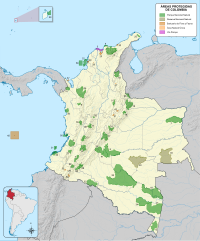Las Hermosas National Natural Park
In this article we will analyze the impact of Las Hermosas National Natural Park on contemporary society. Las Hermosas National Natural Park has been the subject of debate and study for years, and its influence resonates in all areas of modern life. Through a multidisciplinary approach, we will examine the different facets of Las Hermosas National Natural Park and its relevance today. From its impact on popular culture to its implications on the global economy, Las Hermosas National Natural Park continues to be a topic of interest to academics, experts, and the general public. Throughout this article, we will explore the implications and challenges that Las Hermosas National Natural Park poses in today's world, providing new perspectives and reflections on this phenomenon.
| Parque Nacional Natural Las Hermosas | |
|---|---|
| Las Hermosas National Natural Park | |
 Laguna Las Mellizas, Las Hermosas National Natural Park | |
| Nearest city | Santiago de Cali, Colombia |
| Coordinates | 3°32′N 75°57′W / 3.533°N 75.950°W |
| Area | 1,250 km2 (480 sq mi) |
| Established | May 1977 |
| Governing body | SINAP |
The Las Hermosas National Natural Park (Spanish: Parque Nacional Natural Las Hermosas) is a national park located in the Valle del Cauca and Tolima departments, at the highest elevation of Cordillera Central range in the Andean Region of Colombia. Its main feature is probably the wetlands and 387 glacial lakes.
General
The park is bounded by the Magdalena River and Cauca River. Its elevation ranges from 1,600 m (5,200 ft) to 4,400 m (14,400 ft) above mean sea level. The area has a canyon, formed by the surrounding rivers, but it is hard to access. It is of historical importance as it was one of the most defended areas by the indigenous Pijao peoples against the Spanish Conquistadors.
Three types of geological formations are found in the area: intrusive igneous rocks, metamorphic rock and formations from more recent volcanic eruptions.
Climate
Average yearly rainfall is 2000 mm at the lower elevations and 1500 mm above 3,000 m (9,800 ft). Average temperature is 24 °C at the lower elevations, and 4 °C at the highest. December–March and July–August are dry periods.
Flora and fauna
Noteworthy plants include: wax palm trees, Podocarpus oleifolius, Aniba perutilis, Ocotea heterochroma, Chuquiraga jussieui, Passiflora tenerifensis and Andean Walnut.
The most diverse group of fauna are the birds, followed by the mammals and reptiles. Recorded mammals include: spectacled bear, mountain tapir, cougar, oncilla, pudú, white-tailed deer. Fish in the glacial lakes feed on green algae, blue-green algae and unicellular algae found throughout the 387 lakes.
Footnotes
- ^ IUCN 1982, p. 134
- ^ a b c Villegas & Sesana 2007, p. 169
- ^ "Parque Nacional Natural Las Hermosas" (in Spanish). Parques Nacionales Naturales de Colombia. Archived from the original on 22 July 2011. Retrieved 10 July 2010.
- ^ a b c d Villegas & Sesana 2007, p. 170
- ^ IUCN 1982, p. 135
- ^ a b "Naturaleza y Ciencia del Parque Nacional Natural Las Hermosas" (in Spanish). Parques Nacionales Naturales de Colombia. Archived from the original on 22 July 2011. Retrieved 10 July 2010.
References
- Villegas, Benjamin; Sesana, Laura (2007), Colombia Natural Parks, Villegas Asociados, ISBN 978-958-8156-87-3.
- IUCN (1982), IUCN directory of neotropical protected areas (in Spanish and English), IUCN, ISBN 978-0-907567-62-2.

